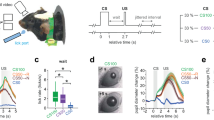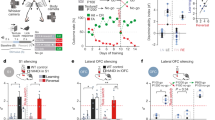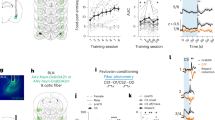Abstract
Reciprocal connections between the orbitofrontal cortex and the basolateral nucleus of the amygdala may provide a critical circuit for the learning that underlies goal-directed behavior. We examined neural activity in rat orbitofrontal cortex and basolateral amygdala during instrumental learning in an olfactory discrimination task. Neurons in both regions fired selectively during the anticipation of rewarding or aversive outcomes. This selective activity emerged early in training, before the rats had learned reliably to avoid the aversive outcome. The results support the concept that the basolateral amygdala and orbitofrontal cortex cooperate to encode information that may be used to guide goal-directed behavior.
This is a preview of subscription content, access via your institution
Access options
Subscribe to this journal
Receive 12 print issues and online access
$209.00 per year
only $17.42 per issue
Buy this article
- Purchase on Springer Link
- Instant access to full article PDF
Prices may be subject to local taxes which are calculated during checkout





Similar content being viewed by others
References
Fuster, J.M. in Cerebral Cortex (eds Jones, E.G. & Peters, A.) 151– 177 (Plenum, New York, 1985)
Goldman-Rakic, P.S. The prefrontal landscape: implications of functional architecture for understanding human mentation and the central executive. Phil. Trans. R. Soc. Lond. 351, 1445–1453 ( 1996)
Petrides, M. Specialized systems for the processing of mnemonic information within the primate prefrontal cortex. Phil. Trans. R. Soc. Lond. 351, 1455–1462 (1996)
Damasio, A R. Decartes Error. (G.P. Putnam, New York, 1994)
Rolls, E.T. The orbitofrontal cortex. Phil. Trans. R. Soc. Lond. 351, 1433–1443 (1996)
Bechara, A., Damasio, H., Tranel, D. & Damasio, A.R. Deciding advantageously before knowing the advantageous strategy. Science 275 , 1293–1294 (1997)
Bechara, A., Damasio, H., Tranel, D. & Damasio, A.R. Dissociation of working memory from decision making within the human prefrontal cortex . J. Neurosci. 18, 428– 437 (1998)
Krettek, J.E. & Price, J.L. Projections from the amygdaloid complex to the cerebral cortex and thalamus in the rat and cat. J. Comp. Neurol. 172, 687–722 (1977)
Kolb, B. Functions of the frontal cortex of the rat: A comparative review. Brain Res. Rev. 8, 65–98 (1984 )
Price, J.L., Russchen, F.T. & Amaral, D.G. in Integrated Systems of the CNS, Part I. Handbook of Chemical Neuroanatomy, Vol. 5 (eds Bjorklund, A. Hokfelt, T. & Swanson, L.W.) 279–388 (Elsevier, Amsterdam, 1987)
McDonald, A.J. Organization of amygdaloid projections to the prefrontal cortex and associated striatum in the rat. Neuroscience 44, 1– 44 (1991)
Gallagher, M. & Chiba, A.A. The amygdala and emotion. Curr. Opinion Neurobiol. 6, 221–227 (1996)
Killcross, S., Robbins, T.W. & Everitt, B.J. Different types of fear-conditioned behavior mediated by separate nuclei within amygdala. Nature 388, 377–380 (1997)
Malkova, L., Gaffan, D. & Murray, E.A. Excitotoxic lesions of the amygdala fail to produce impairment in visual learning for auditory secondary reinforcement but interfere with reinforcer devaluation effects in rhesus monkeys. J. Neurosci. 17, 6011–6020 (1997)
Hatfield, T., Han, J.-S., Conley, M., Gallagher, M. & Holland, P. Neurotoxic lesions of basolateral, but not central, amygdala interfere with pavlovian second-order conditioning and reinforcer devaluation effects. J. Neurosci. 16, 5256 –5265 (1996)
Balleine, B.W., Leibeskind, J.C. & Dickinson, A. Effect of cell body lesions of the basolateral amygdala on instrumental conditioning. Soc. Neurosci. Abstr. 23, 786 (1997)
Jones, B. & Mishkin, M. Limbic lesions and the problem of stimulus-reinforcement associations. Exp. Neurol. 36 , 362–377 (1972)
Kling, A., Steklis, H.D. & Deutsch, S.D. in The Neurobiology of the Amygdala (ed Eleftheriou, B.E.) 611–632 (Plenum, New York, 1972)
Brown, S. & Schaefer, E.A. An investigation into the function of the occipital and temporal lobe of the monkey's brain. Phil. Trans. R. Soc. Lond. 179, 303 ( 1888)
Kluver, H. & Bucy, P.C. Preliminary analysis of functions of the temporal lobes in monkeys. Arch. Neurol. Psychiatry 42, 979–1000 (1939)
Kolb, B. in The Cerebral Cortex of the Rat (eds Kolb, B. & Tees, R.C.) 437– 458 (MIT Press, Cambridge, Massachusetts, 1990)
Schoenbaum, G. & Eichenbaum, H. Information coding in the rodent prefrontal cortex. I. Single neuron activity in orbitofrontal cortex compared with that in piriform cortex. J. Neurophysiol. 74, 733–750 (1995)
Schoenbaum, G. & Eichenbaum, H. Information coding in the rodent prefrontal cortex. II. Ensemble activity in orbitofrontal cortex. J. Neurophysiol. 74, 751–762 (1995)
Critchley, H.D. & Rolls, E.T. Olfactory neuronal responses in the primate orbitofrontal cortex: analysis in an olfactory discrimination task. J. Neurophysiol. 75, 1659– 1672 (1996)
Fuster, J.M. Unit activity in the prefrontal cortex during delayed response performance: Neuronal correlates of short-term memory. J. Neurophysiol. 36, 61–78 (1973)
Niki, H. Differential activity of prefrontal units during right and left delayed response trials. Brain Res. 70, 346–349 ( 1974)
Funahashi, S., Bruce, C.J. & Goldman-Rakic, P.S. Mnemonic coding of visual space in the monkey's dorsolateral prefrontal cortex. J. Neurophysiol. 61, 331–349 (1989)
Miller, E.K., Erickson, C.A. & Desimone, R. Neural mechanisms of visual working memory in prefrontal cortex of the macaque. J. Neurosci. 16, 5154–5167 (1996)
Fuster, J.M., Bauer, R.H. & Jervey, J.P. Cellular discharge in the dorsolateral prefrontal cortex of the monkey in cognitive tasks. Exp. Neurol. 77, 679–694 (1982)
Watanabe, M. Reward expectancy in primate prefrontal neurons. Nature 382, 629–632 (1996)
Acknowledgements
We thank T. Lam for assistance in figure preparation, Dr. M. Burchinal and E. Neebe for statistical consultation. This work was supported by funding from the NIH.
Author information
Authors and Affiliations
Corresponding author
Rights and permissions
About this article
Cite this article
Schoenbaum, G., Chiba, A. & Gallagher, M. Orbitofrontal cortex and basolateral amygdala encode expected outcomes during learning. Nat Neurosci 1, 155–159 (1998). https://doi.org/10.1038/407
Received:
Accepted:
Issue Date:
DOI: https://doi.org/10.1038/407
This article is cited by
-
Dopamine projections to the basolateral amygdala drive the encoding of identity-specific reward memories
Nature Neuroscience (2024)
-
Basolateral amygdala and orbitofrontal cortex, but not dorsal hippocampus, are necessary for the control of reward-seeking by occasion setters
Psychopharmacology (2023)
-
Medial orbitofrontal cortical regulation of different aspects of Pavlovian and instrumental reward seeking
Psychopharmacology (2023)
-
Mapping effective connectivity of human amygdala subdivisions with intracranial stimulation
Nature Communications (2022)
-
Stress induces insertion of calcium-permeable AMPA receptors in the OFC–BLA synapse and modulates emotional behaviours in mice
Translational Psychiatry (2020)



